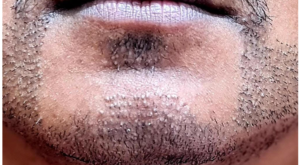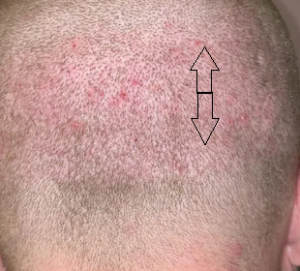I was at a hair transplant meeting last week and heard an amazing discussion of cloning that reflects we are closer than I thought to achieving hair cloning. The above link suggests that a drug might regenerate a tooth, certainly on the complexity of a hair follicle. I see a bright future for hair cloning, although getting it through the FDA might take 5+ years once it is achieved. Be patient.
Finasteride works for all men of any age by either slowing the loss, stopping the loss, or reversing the hair loss. Reversal occurs more in younger men but often in the crown, even in older men. A friend of mine was put on Proscar (finasteride 5mgs dose), and he grew back much of his lost hair in the crown and even a little bit in the frontal area. One never knows so “never say never”.
About me: 48, thinning since +- 25, first bald spot around 12 years ago. Somewhere between NW4 and 5 right now. It’s pretty bad. Then, 4,5 years ago, I bought a lot of finasteride, and I started with 1mg/day and 5% minox twice a day… I hated that I had a big bald spot on the back of my head, and I thought..why not give it a try? Tried for a little over 8 months. No visual difference! Nothing! Sadly, I was a non-responder. I gave up. Then I heard about microneddling so I tried to add this to my routine. That was 3 months ago, and today I see a lot of new baby hairs filling up my bald spot. I think that in another few months, my hair will have grown back.
Microneedling seems to transform many men with hair growth unachieved through other mechanisms.
Humans do not have seasonal sheds of hair as our hair sheds asynchronously. Most mammals, on the other hand, shed seasonally, i.e. synchronal shedding.
You likely lost your native hair by not taking finasteride, a mistake. There appeared to be a lot of native hair loss that was present before the hair transplant. I don’t know enough about you to give you clear direction. In effect, it seems that you are no better than you were before the hair transplant, as you largely replaced your natural hair with transplanted hair, and much of the transplanted hair might not have even grown out. The before picture is on the left.
Hello Dr Rassman, I was wondering if I could geta HT at 21, I’m on finasteride and minoxidil since 2 years (both oral) I have pretty much stabilised my hair loss and have gotten the maximum regrowth possible from these pharmaceutical treatments, I wonder can a HT be done so that I do not sacrifice my prime years and youth worrying about hairs? I’m okay to be on pharmaceuticals for life, currently I’m NW 2.5-3.
Hair loss comes from apoptosis, which is hair-cell genetic death. We are born with a finite number of hair cycles. Let’s say some of your hairs at the hairline level, had a 7-year cycle that is genetically programmed, others might cycle 9 times while others might cycle 10 times genetically. Assuming that your hair cycle is 3 years (average for young men), the hair would fall out at the end of each cycle, only to regrow again after it goes through a sleep phase (Telogen). But if you have genetic balding that limits the frontal hairs to 7 cycles and the cycles last 7 years, that means you might lose your frontal hairline hair at the age of 21 (7 cycles programmed to last 3 years each). Do the calculations yourself. That is the reason I don’t do hair transplants on men under 25, because many have apoptosis genetically ingrained in some hair follicles that fall out when they are 23, 24, 25, 26, 27 etc… Do you get it?
For me, it is important to build a personalized Master Plan for each patient, projecting what I think is going to be his hair loss pattern so I can balance the donor supply against the loss. Too many young men go to Turkey, get 4000 grafts in the frontal 1 1/2 inches in thair hairline, and end up using up more than 50% of the donor supply in the process, so when they turn 27 or 30, their hair loss may go back to the crown, and when they want a hair transplant again, they may not have enough hair to do it.
This is common when the surgeon leaves the graft sticking out of the beard after placement. This often occurs when using a Choi-type implanter and the way it is used. Most doctors who understand this, use this instrument to place the grafts flush with the surrounding beard after implantation, thus avoiding this complication. Repair is a problem because any treatment, such as dermabrasion, or CO2 Laser, may cure the cobblestoning but change the color of the skin.
This was taken over the phone so the sound quality was not great. Show patience, as there are many good insights in this podcast that will give you a better understanding into (1) the hair transplant field, and (2) the changes that occurred over the past 34 years, including the development of FUE and (3) what is coming in the future regarding drugs and breakthrough instrumentation. Here is the podcast: https://youtu.be/3qiXzTDBUGs
I’m 5 days post hair transplant(5800 grafts). Just wondering if anyone has a remedy to make the heavy head, sore neck, lingering numb feeling from the extractions feel better?
Five thousand five hundred grafts will cause a lot of healing and fluid movement into the recipient area, making your head feel heavier. In addition, numbness is not uncommon as small nerves are routinely cut during the surgery, and the tingling you feel reflects the healing of these nerve endings.
I am devastated. Three days ago one of my patients, who had been badly operated on in Turkey, committed suicide. I had seen him in emergency following his bad operation and had proceeded to remove part of the grafts. I saw him again via skype a few days ago and he exclaimed “my savior” …. There was still work to be done and I was enthusiastic about the idea of completing the correction work….
This isn’t the first time I’ve heard about suicide from patients who’ve been badly operated on, especially when it comes to beards. It’s a terrible ordeal for them to have this bad work in their face. I have a terrible grudge against all those who work badly and who shamelessly and remorselessly ruin the future of young men….
I had a long talk with his parents this morning. They explained to me that their son was consumed with remorse at having been taken in by dishonest people. The sad thing is that correction was possible. He was very concerned about the depletion of his donor area. And he asked me to bring as many grafts as possible to the scalp donor area. The first part of his correction went smoothly, with very good healing of the face, but the feeling that he had mortgaged his future was stronger. He left a long, beautiful and dignified letter which I was unable to read, but which comforted his parents. I think it would indeed be good for the ISHRS and for fight to fight to do an in memoriam to give an example of the psychological risk a patient can take by putting himself in non-expert hands.
Dr. Rassman’s comments: In the early to mid 90s, I had three patients that were suicidal as a result of the big plugs that they received for a hair transplant. In those days it wasn’t Illegal Clinics in Turkey, it was American and European doctors that did the deforming surgeries. One young man who committed suicide, Affected me greatly. I Remember talking to his parents before the suicide trying to work with them and comfort him. I offered my services free of charge to fix it. But he couldn’t deal with the stress and prior to the scheduled surgery with me, when he was about to fly out to see me from Ohio, he committed suicide. The family called me to thank me for my efforts. It didn’t make me feel better. The other two got help that I arranged for them. None of these three patients were in California where I practiced. A forth developed Alopecia Areata within a week after his Hair transplant. Dr. Ron Shapiro and I worked with a psychiatrist and prevented the suicide arranging 24/7 care for him after he was properly medicated. He did fine. Bad surgery is not confined to Turkey Black Market Clinics, it happens in our own back yard with poorly trained surgeons offering hair transplants without understanding the fundamentals. Shame on them.
How much density is needed for fine hair to look thick & dense (not transparent) at the hairline? Have you ever seen cases with super fine hair, that achieved good density?
Normal density in a fine-haired individual (like what you had at 15 years of age) was never an Elvis hairline, and you know it. It is impossible to put enough very fine hair to get an Elvis hairline, but you can get the look of what you had when you were 15.
It has been 5-6 weeks now since my hair transplant, no shedding so far. Also started taking fin 1 week after the HT. I can not stop touching my scalp and the new hair. I hope it does not ruin the transplant in some way but I am just super happy. Also since the HT I have a lot dandruff is this normal?
What you are calling dandruff, could be scales from the hair transplant. Touching or scratching your recipient site grafts increases the risk of folliculitis. If you feel you must touch it, wash your hands and touch it with the palm of your hand.
I have walked outside very briefly to do things like get groceries. I’ve also driven places with the sun coming through the car windows and sat in the car with the sun blockers down. Is this enough to have ruined my hair transplant? I’ve noticed one side seems thicker than the other and I’m about 19 days after surgery. I didn’t know the sun exposure issue was something that you’re supposed to avoid so hardcore or for so long (‘m reading anywhere from 3-6 months).
The hair transplant has skin at the top of the graft. This skin, which comes from the back of the head, has been protected by the hair for your entire life. They will get sunburned quickly when they are in the recipient area because they never saw the sun. Protecting these grafts is important. I have seen some men with multiple red dots on the transplanted grafts, reflecting a sunburn to the tops of these grafts. It takes months for these grafts to be able to tolerate the sun. In addition, the UV Light may not be great for healing.





